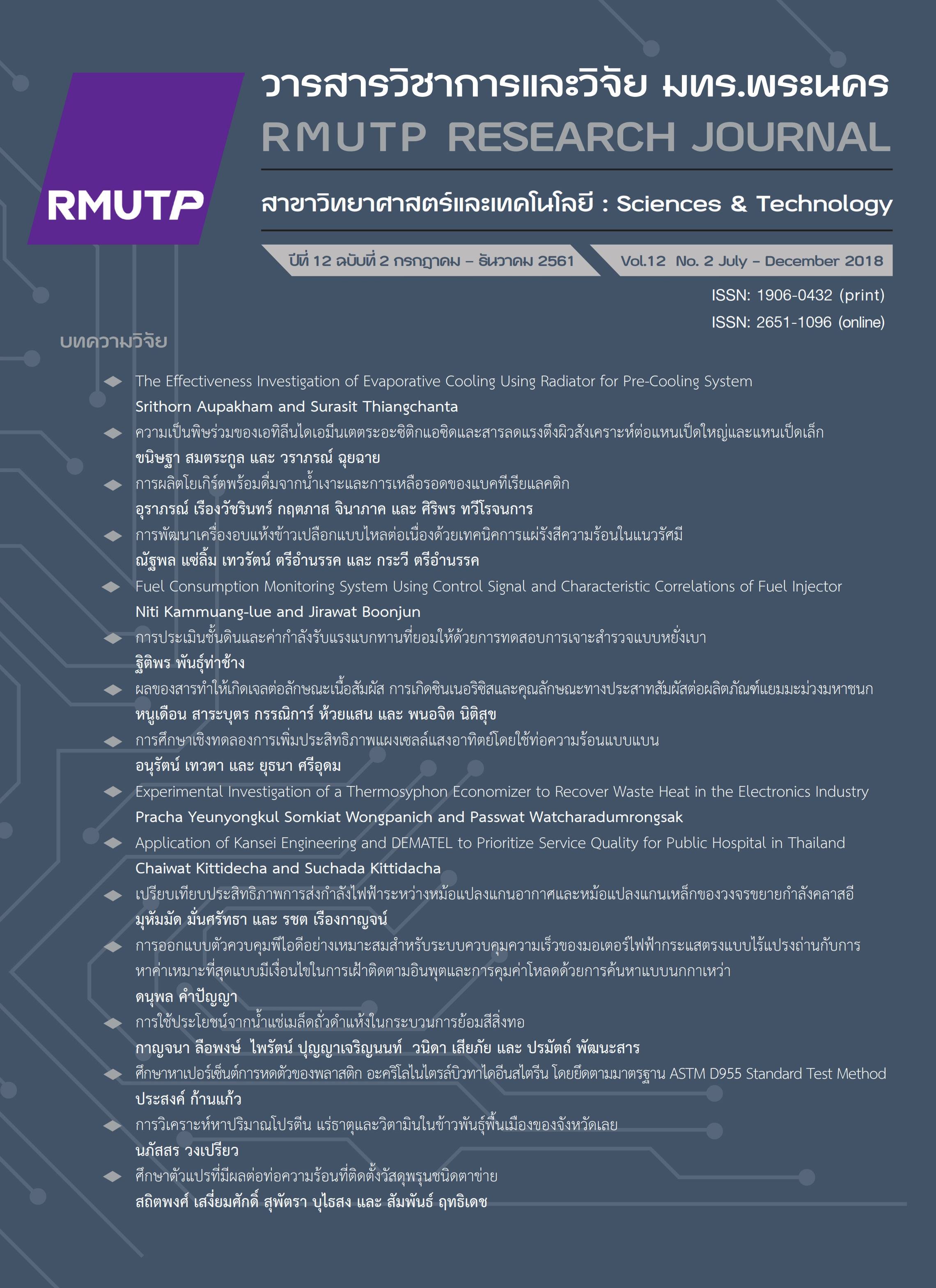Co-Phytotoxicity of Ethylenediaminetetraacetic Acid and Synthetic Surfactants on Spirodela polyrrhiza and Lemna perpusilla
Main Article Content
Abstract
Using of ethylenediaminetetraacetic acid (EDTA) and synthetic surfactant increase the contamination of both chemical in water. The co-phytotoxicity of 0 – 20 mg/l EDTA and 3 synthetic surfactants; that are 0-10 x CMC of Triton X-100 and Tween 80 and 0-2 x CMC of sodiumdodecylsulfate (SDS) on growth of Spirodela polyrrhiza and Lemma perpusilla were studied for 3 days. The results showed that surfactant were phytotoxic on growth of both plants while EDTA was not toxic. SDS was the most toxic to plant especially on all chlorophyll content. Triton X-100 was only toxic to growth of L. perpusilla. Tween 80 was less toxic to both plants. This surfactant only decreased chlorophyll a and total chlorophyll content of S. polyrrhiza and L. perpusilla. There were not any interaction between EDTA and surfactant for most toxicity test. With these results, synthetic surfactant contamination should be more concern than co-contamination with EDTA
Article Details
References
[2] Y. Huang and A.A. Keller, “EDTA functional magnetic nanoparticle sorbents for cadmium and lead contaminated water treatment,” Water Research, vol. 80, pp. 159-168, Sep. 2015.
[3] E. Bloem, S. Haneklaus, R. Haensch and E. Schnug, “EDTA application on agriculture soils affects microelement uptake of plants. Science of the Total Environment. Vol. 577, pp. 166-173, Jan. 2017.
[4] C. Oviedo and J. RodrÍguez, “EDTA: The chelating agent under environmental scrutiny,” Química Nova, vol. 26, pp. 901-905, Nov. 2003.
[5] F.G. Kari and W. Giger, “Speciation and fate of ethylenediaminetetraacetate (EDTA) in municipal wastewater treatment,” Water Research, vol. 30, pp. 122-134, Jan. 1996.
[6] R. Lanigan and T. Yamarik, “Final report on the safety assessment of EDTA, calcium disodium EDTA, diammonium DETA, dipotassium EDTA, disodium EDTA, TEA-EDTA, tetrasodium EDTA, trisodium EDTA, HEDTA and trisodium HEDTA,” International Journal Toxicology, vol. 21, pp. 95-142, Oct. 2002.
[7] O. Barrutia, C. Garbisu, J. Hernández-Allica, J.I. García-Plazaola and J.M. Becerril, “Diifereces in EDTA-assisted metal phytoextraxtion between matallicolous and non-metallicolous accessions of Rumex acetosa L.,” Environmental Pollution, vol. 158, pp. 1710-1715, May. 2010.
[8] J. Hernández-Allica, C. Garbisu, O. Barrutia and J.M. Becerril, “EDTA-induced heavy metal accumulation and phytotoxicity of cardoon plants,” Environmental and Experimental Botany, vol. 60, pp. 26-32, May. 2007.
[9] A.D. Vassil Y. Kapulnik I. Raskin and D.E. Salt, “The role of EDTA in lead transport and accumulation by Indian mustard,” Plant Physiology, vol. 117, pp. 447-453, Jun. 1998.
[10] S.E. Meers, M. Qadir, P. de Caritat, F.M.G. Tack, G.D. Laing and M.H. Zia, “EDTA-assisted Pd phytoextraction,” Chemosphere, vol. 74, pp. 12791291, Mar. 2009.
[11] M.J. Scott and M.N. Jones, “The biodegradation of surfactants in the environment,” Biochimica et Biophysica Acta (BBA) - Biomembranes, vol. 1508, pp. 235-251, Nov. 2000.
[12] E. Lowry, M. Sedghi and L. Goual, “Molecular simulations of NAPL removal from mineral surfaces using microemulsions and surfactants,” Colloids and Surfaces A: Physicochemical and Engineering Aspects, vol. 506, pp. 485-494, Oct. 2016.
[13] G.-G. Ying, “Fate, behavior and effects of surfactants and their degradation products in the environment,” Environment International, vol. 32, pp. 417-431, Apr. 2016.
[14] D. Feruzan, Y. Gülden, A. Halide, Ö Fatmanur and L. Sinem, “Phytotoxic effects of nonionic surfactant octylphenol series (Triton X-100, Triton X-114, Triton X-405) on onion.” Asian Journal of Chemistry, vol. 24, pp. 5746-5748, Dec. 2012.
[15] G. Chang, Q. Zhang, L. Zhang, Y. Lü and T. Gao, “Effect of sodium dodecyl sulfate on wheat (Triticum aestivum L.) seedlings,” Environmental Progress and Sustainable Energy, vol. 34, pp. 1142-1147, Feb. 2015.
[16] C. Forni, R. Braglia, F.J.M. Harren and S.M. Cristescu, “Stress response of duckweed (Lemna minor L.) and water velvet (Azolla filiculoides Lam.) to anionic surfactant sodium-dodecyl-sulphate (SDS),” Aquatic Toxicology, vol. 110-111, pp. 107-113, Apr. 2012.
[17] A.C. Agnello, D. Huguenot, E.D. van Hullebusch and G. Esposito, “Phytotoxicity of citric acid and Tween® for potential use as soil amendments in enhanced phytoremediation,” International Journal of Phytoremediation, vol. 17, pp. 669-677, Jan. 2015.
[18] Y. Gao, W. Ling, M.H. Wong, “Plant-accelerated dissipation of phenanthrene and pyrene from water in the presence of nonionic surfactant,” Chemosphere, vol. 63, pp. 1560-1567, Jun. 2006.
[19] M. Cheng, G. Zeng, D. Huang, C. Yang, C. Lai, C. Zhang and Y. Liu, “Advantage and challenges of Tween 80 surfactant-enhanced technologies for the remediation of soils contaminated with hydrophobic organic compounds,” Chemical Engineering Journal, vol. 314, pp. 98-113, Apr. 2017.
[20] HIS Markit [2015], “Specialty chemicals update program surfactants,” [Online]. Available from: https://www.ihs.com/products.chemical-surfactants-scup.html [Cited December 17, 2017]
[21] X.-D. Huang, Y. El-Alawi, D.M. Penrose, B.R. Glick and B.M. Greenberg, “Response of three grass species to creosote during phytoremediation,” Environmental Pollution, vol. 130, pp. 453-463, Aug. 2004.
[22] M.M. Singer and R.S. Tjeerdema, “Fate and effects of surfactant sodium dodecyl sulfate,” Reviews of Environmental Contamination and Toxicology, vol. 133, pp. 95-149, 1993.
[23] E.A.Solomonova and S.A. Ostroumov, “Tolerance of an aquatic macrophyte Potamogeton crispus L. to sodium dodecyl sulphate, “ Moscow University Biological Sciences Bulletin, vol. 62, pp. 176-170, Dec. 2007.
[24] W. Geebelen, J. Vangronsveld, D.C. Adriano, L.C. van Poucke and H. Clijsters, “Effects of Pb-EDTA and EDTA on oxidative stress reactions and mineral uptake in Phaseolus vulgaris,” Physiologia Plantarum, vol. 115, pp. 377-384, Jul. 2002.

